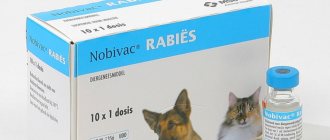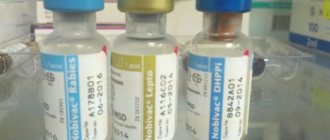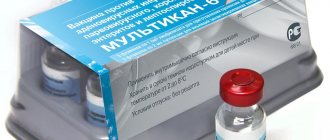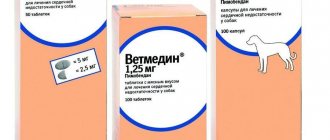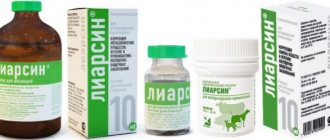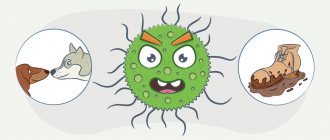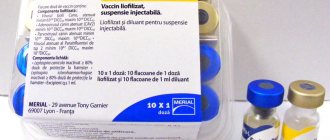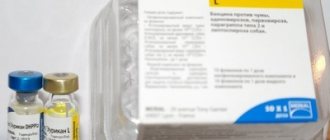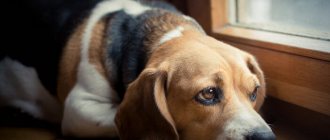| Description of the drug | |
| Release form and storage conditions: | Vaccines in the form of a dry part (white or pinkish powder) and a liquid solvent (clear liquid), are packaged in glass ampoules; Shelf life of the powder is 24 months at a temperature of 2-8°C, shelf life of the solvent is 60 months at 2-25°C |
| Price: | 70-750 rubles per 1 dose (1 ml bottle) depending on the type of vaccine |
| Analogues: | Multikan, Geksakanivac, Dipentovak |
Instructions for use and dosage
It is recommended to vaccinate cats and dogs (as well as ferrets, foxes, raccoons, minks) from 3 months.
The vaccine is administered subcutaneously or intramuscularly in an amount of 1 ml, which is 1 dose. If for some reason the animal was vaccinated earlier, it is necessary to vaccinate the animal again at this age. Livestock (sheep, goats, horses, cattle) are vaccinated from 6 months.
1 dose of vaccine (1 ml) is administered intramuscularly.
If the animal was vaccinated before 6 months, then it is vaccinated again at 6 months of age.
Vaccination can only be given to healthy animals. Pregnant females can also be vaccinated with this vaccine. They are vaccinated intramuscularly.
If the owner wishes to vaccinate the animal himself, he must remember that:
- 10 days before vaccination (at least), the pet must be treated against parasites;
- after vaccination, do not wash for at least 10 days;
- in the coming days after vaccination (two weeks) do not change your diet;
- during the first vaccination, do not allow contact with other animals for 2 weeks (the entire quarantine period);
- You should take special care of your pet for 2 weeks - do not overload, do not tire, do not overcool.
During the first 3 days after vaccination, you should especially carefully monitor your pet's condition.
Before vaccination, the vaccine bottle must be warmed to the pet’s body temperature. This can be done under running hot water.
After the bottle is opened, it is administered immediately. The syringe used is only sterile. Disposable. After injection, the vial and syringe should be burned.
The injection site is not wiped with anything, so as not to disrupt the proper action of all strains of the vaccine.
Before vaccination, the vaccine bottle must be warmed to the pet’s body temperature.
Reviews
Lisa: “Last year I vaccinated my two dogs with Nobivac. First complex, then from rabies. The pets tolerated all the injections normally, with no side effects, loss of appetite or well-being. The drug worked with a bang: the neighbor’s dog, with whom mine constantly communicate, fell ill with distemper, but this dirty trick bypassed us.”
Anna: “I have a very timid dog, he hates injections, and constantly throws tantrums. But he tolerates Nobivac injections calmly. After the vaccination, his health does not change: no drowsiness, he eats and plays as always. Excellent inexpensive product."
Nadezhda: “I’ve been vaccinating my dog with Nobivak for four years now. It’s a high-quality drug, the dog always tolerates it well, our vet uses only this vaccine.”
Olga: “I have extensive experience in keeping animals - from dogs to ferrets. I always vaccinated everyone with Nobivak. Now there are two huskies living in the house: workers, for hunting. The eldest dog is already 11 years old. And during all this time I have never fallen ill with infectious diseases, and always tolerate vaccination well.”
Igor: “A good friend’s dog died after being injected with Nobivac. Half an hour later, a terrible allergy appeared, the puppy was swollen to the point of a balloon. We turned around halfway home and back to the clinic, but we couldn’t save the animal.”
Lily: “I have a Yorkie puppy. We did the first vaccinations ourselves, because... We were given a kitten that was not vaccinated. I was terribly worried, carefully chose the drug and settled on Nobivak. The baby tolerated both vaccinations well: he slept a lot, tried to reach the injection site (apparently it was itching), but he ate well.”
Contraindications and side effects
The drug may be contraindicated in a dog if it is highly sensitive to the contents of the injection. It is worth abandoning Nobivac DHPPi if the dog is sick.
After the injection, hypersensitivity to the medication may occur. To eliminate undesirable consequences, it is necessary to apply adrenaline under the skin in such doses as the veterinarian deems necessary. If the animal develops swelling in the area of the injection, it’s okay - it will disappear without a trace in fourteen days.
Important! If your pet does not go outside, this does not guarantee that he is completely healthy. The reason for this is that dangerous diseases are very resistant to virus carriage and change the carrier
Viruses can be found on shoes or other things that you bring in from the street. Therefore, without a vaccine injection, the animal can become seriously ill.
Contraindications for use
Contraindications for the use of the drug are:
- diseases of the dog that lead to decreased immunity;
- weakened and exhausted state of the animal;
- damage by endo and exoparasites.
Sick and weakened individuals are exempt from the administration of such drugs.
Revaccination procedure
Revaccination can be carried out at home on your own if the dog had no side effects or allergic reactions when using the product for the first time. Revaccination is carried out only for healthy animals, subject to strict adherence to certain rules:
- Before use, the dry vaccine powder should be diluted with Nobivac Diluent. It is strictly forbidden to use a vaccine that has expired. It must be disposed of after pre-boiling for 15 minutes. Drugs produced in liquid form only need to be drawn into a sterile syringe.
- Then you need to prepare the dog's skin by treating it with an antiseptic solution.
- The solution is administered only subcutaneously. To do this, insert a 2 mm needle.
- The drug is administered very slowly; after injection, treat the injection site with an antiseptic.
- To administer an intranasal vaccine, use a special nozzle. Before use, the bottle with the drug must be shaken well, drawn into a syringe and injected into each nasal passage of the dog.
How to vaccinate yourself
It is better to give the first vaccinations to a veterinarian, then you can give the injections yourself, following the instructions for the drug. It is important to remember that you cannot vaccinate an animal that is weakened by illness or is sick; the veterinarian will be able to determine the malaise. Before administering the vaccine, it is necessary to carry out deworming. If the owner does not observe changes in the dog’s behavior, then the procedure can be carried out. There is the following sequence of actions:
- Open the bottle of dry vaccine (it should be diluted with 1 ml of Diluent solvent), shake the finished mixture before use. Nobivac Lepto and L4 are sold ready-made and can be directly drawn into a syringe.
- Prepare the skin on the withers for injection: clean the area from dirt to avoid infection, make sure there are no wounds.
- Immobilize the dog's head so that it does not jerk during the injection.
- Vaccines are administered under the skin (2-3 mm), it is important to remember that the injections are not intramuscular.
- After injecting the drug, remove the needle and treat the area with an antiseptic.
The intranasal vaccine Nobivac KS is easier to use. The instructions for use of the drug suggest starting prophylaxis from the age of two weeks. The Nobivak intranasal vaccination for puppies is injected into the nostril. To vaccinate, shake the bottle, draw the contents into a sterile syringe, then use a special nozzle to inject the drug into the nose.
Features of dog vaccination
Instructions for administering the vaccine for dogs Nobivak are mandatory for people who plan to administer the injection for the first time.
It is worth paying attention to the fact that vaccination of pets should only be carried out by a specialist. Below is a vaccination schedule with Nobivak
| Primary vaccine | Secondary vaccine | |||
| 8-10 weeks | 12 weeks | 14 weeks | ||
| 4-6 weeks | Puppy DP | DHP or DHPPi+L | DHP or DHPPi+L(R) | — |
| 8-10 weeks | DHP or DHPPi+L | DHP or DHPPi+L(R) | — | |
| 12 weeks | DHP or DHPPi+L(R) | L |
First vaccination
10 days before vaccination, it is important to give your pet an anti-worm medication. There are many drugs in this category, from which you can choose any
If it is difficult to decide on a drug for worms, then you need to consult a veterinarian. The remedy for worms should be given to the pet in the morning on an empty stomach, and after 30 minutes you need to pour in Vaseline oil. After 10 days, the puppy is vaccinated. After immunization, it is recommended to ensure complete rest for the pet and avoid contact with other animals. Second vaccination. After the first injection, you should count 2-3 weeks until the second vaccine is administered. After 3 weeks, preliminary deworming is carried out, as before the first vaccination. After the second vaccine is administered, the quarantine ends 2 weeks later and the animal is released for a walk. Third vaccination. The third vaccination is usually given at 3 months of age. Likewise, it is important to carry out preliminary deworming, and then resort to the procedure. Subsequently, vaccination is carried out at the age of 1 year, and at intervals of 12 months.
Price
The cost of Nobivac for dogs depends on the type of vaccine. You can buy it inexpensively in an online store, where you can easily order the desired drug, pre-selected in the catalog. Prices for Nobivak in Moscow:
| Nobivak drug | price, rub. |
| KS | 650-700 |
| DHPP and DHPPi | 250-300 |
| Rabies and R.L. | 100-150 |
| Lepto, L4 | 50-60 |
Complications after vaccination and side effects
Complications after vaccination in cats do not often occur. In any case, the animal owner must be aware of some of them in order to promptly notice and protect the animal. One of the dangerous complications after vaccination is the development of chronic renal failure.
In the course of research conducted by scientists, a direct connection was established between the development of chronic disease in cats and a complex vaccine against rhinotracheitis, calicivirosis and panleukopenia. This is due to the fact that the viral agents used to create the vaccine are grown in cell cultures.
Another complication after vaccination is an allergic reaction that occurs in response to the introduction of foreign agents into the body. The most serious manifestation of an allergy to a vaccine is anaphylactic shock. The development of the reaction occurs rapidly, affecting the respiratory system of the animal.
Allergic reactions that occur during vaccination include:
- vasculitis;
- hemolytic type anemia;
- thrombocytopenia.
In order to avoid side effects, it is necessary to minimize the risk by adhering to the following rules:
- do not immunize frequently (according to the schedule of vaccinations);
- weigh all factors before immunization each time;
- It is recommended to measure the antibody titer in the bloodstream before each vaccination in order to assess the need for vaccination against a particular disease.
Composition and description of the vaccine Nobivak Rabies
The Nobivak Rabies vaccine is manufactured in the format of an injection suspension. It contains killed virus rabies.
In order for the pet's immune system to more intensively produce immune cells in response to exposure to the substance, an adjuvant is included in the medication. In addition, the drug contains compounds that help the body respond correctly to the serum.
The suspension has a pink or yellow color, the intensity of which may vary. In pet stores and veterinary pharmacies it is sold in transparent glass bottles. The volume of each bottle is 1 ml. They are sealed with rubberized plugs, which are additionally secured with a tape made of thin and flexible aluminum. Along with the bottles, an instruction is placed in a cardboard box with a description and diagram of the use of the drug.
Types of Nobivak vaccine for dogs
Puppies receive part of their immunity from their mother.
As a rule, antibodies obtained from mother's milk can protect the baby only until the age of eight weeks, and then they gradually disappear. Therefore, there is a risk of infection of a young animal with distemper or infectious enteritis. To protect the puppy’s body, a special vaccine Nobivak PuppyDP has been developed to protect the puppy’s body from the virus of fatal diseases. The drug is used when the animal is four weeks old. After a single use, the body receives protection from canine distemper and parvovirus enteritis. The vaccine is produced in powder form and is diluted with a special solvent before use. The dose does not depend on age, weight or breed. The injection is placed under the skin. Immunization is necessary if there is a possible risk of infection of the entire litter or an upcoming long-distance trip.
The Nobivak DHPP vaccine is intended for use in puppyhood, providing protection of the body against parvovirus enteritis, infectious hepatitis, and canine distemper. It is used when the puppy is two months old. The drug is administered subcutaneously or intramuscularly. The guaranteed effect occurs only after twice use with a break of 21 days.
- The dog vaccine Nobivac KS is used in the form of nasal drops and is prepared immediately before use. The animal does not experience stress from the injection, since the drug is injected into the nose using a syringe. Sneezing may be a reaction to the medicine. This vaccine is safe and non-toxic. It can be used to immunize pregnant animals and puppies from 14 days of age.
- Nobivak L or Nobivak L4 - Lepto protects dogs from infection with leptospirosis and prevents the possibility of carrying a dangerous disease. Leptospirosis is dangerous not only for animals, but also for humans, since even after recovery the animal is able to release active viruses into the environment. The drug is produced in the form of a suspension, which can be used in conjunction with other Nobivak vaccines. Very often, when vaccinating dogs after three months, veterinarians dilute the complex vaccine not with a solvent, but with the Nobivak L vaccine.
- Nobivak R and LR are rabies vaccines, the use of which is mandatory for all animals. Without a mark in the veterinary passport, the dog cannot participate in exhibitions or be allowed to be transported on any transport. To prevent a fatal disease, owners can get a mandatory free vaccination or use the Nobivak R or Nobivak RL vaccine. The vaccine is produced in the form of a suspension for subcutaneous or intramuscular use. It is used as a solvent for complex vaccines or independently. Vaccination is carried out once a year.
- Nobivac DHPP is a comprehensive vaccine for the prevention of viral hepatitis, canine distemper, parainfluenza and parvovirus enteritis. Nobivac DHPPi is used for animals from eight weeks of age. Nobivac dhppi is diluted with a solvent and used subcutaneously. The Nobivac DHPPI vaccine is administered again at 12 weeks, then once a year.
Nobivac Diluent is a sterile diluent consisting of sodium hydrogen phosphate, potassium dihydrogen phosphate and water for injection.
Nobivac for dogs against leptospirosis is used after the dog changes teeth, as well as for immunizing adult animals. It protects the body from rabies and leptospirosis.
Very often, veterinarians recommend vaccinating dogs against parainfluenza and bordetellosis, which affect the dog’s upper respiratory tract and are very dangerous especially for young animals and puppies.
Vaccination schedule with Nobivak
A specific regimen can be prescribed individually depending on the breed and size of the dog. The ideal option would be to vaccinate with several types of Nobivak vaccine as the puppy grows older. For the first year, a similar plan would be suitable:
- Puppy DP vaccination at 1.5-2 months (subcutaneous);
- Inoculate DHP and L4 together at 8 weeks (subcutaneous);
- At 3-6 months you need to repeat the vaccination and add a strain of rabies, Nobivak DHPPI and RL are suitable;
- The last vaccination is repeated annually; in favorable conditions, revaccination is allowed once every 2 years.
This scheme is an example of a grafting option. You can choose other Nobivak vaccines or products from another company; it is important that the puppy receives protection from all dangerous diseases.
Composition and pharmacological properties
Depending on the type of drug, the content of vaccine strains will be different. For the most part, the solutions are similar, but have detailed properties. Nobivak DHPPI is considered the most complex; using its example, you can consider the common components of all mixtures:
- Plague strain (4.0 LH);
- Adenovirus strain (4.0 LH);
- Parvovirus strain (7.0 LH);
- Parainfluenza strain (5.5 LH).
The solvent contains water for injection, phosphate buffer solution.
Similar inactive strains contain other vaccines, to which a strain of rabies and leptospirosis can be added.
Effect of the drug
Like all vaccines, Nobivak drugs are based on the work of inactive strains (samples of viral bodies), which are introduced into the animal’s body, but do not have sufficient strength to attack it. At this time, the dog's immune system studies microorganisms and “learns” to resist them. Thus, after infection with a live virus, antibodies will be able to protect the dog’s organ systems.
Depending on the type of vaccination, the duration of protection is 12-36 months. The drug begins to work within 12-15 days, this time is called quarantine.
Indications for use
Indications for the use of specific types of vaccines depend on their functional effects. The full range of vaccinations is carried out for preventive purposes, and not after infection. The manufacturer assures that its products will reliably protect pets from dangerous viral diseases.
- Rabies is the most dangerous and intractable disease that destroys the dog’s central nervous system. It is also dangerous for humans. An animal can become infected from wild animals after a bite or through close contact with other domestic animals. The route of transmission is from saliva to blood. Characteristic symptoms are photophobia, convulsions, and severe drooling.
- Parvovirus enteritis is a viral disease that destroys the intestines and, in some cases, the heart of an animal. Transmitted through the feces of infected animals. Causes severe acute poisoning, diarrhea, vomiting, and a cadaverous odor. If the cells of the cardiovascular system are destroyed, the pet breathes heavily.
- Infectious hepatitis or adenoviral enteritis affects the liver, intestines, lungs, stomach, and nervous system. Caused by a blood-borne virus. Vivid signs are anemia, yellowing of the whites of the eyes and mucous membranes, fever, convulsions.
- Carnivore distemper is not dangerous to humans, but is fatal to pets in the absence of high-quality, quick treatment. Symptoms directly depend on the affected area. An obvious virus is keratinization of the skin and scabs on the surface of the epidermis.
- Parainfluenza is an insidious disease; the virus targets the lungs, then the gastrointestinal system and blood vessels. Manifests itself in the form of severe nasal discharge, coughing, sneezing, shortness of breath, anemia, and thirst.
- Leptospirosis is a bacterial disease that affects the kidneys, liver and circulatory system. In severe cases, it kills the internal microflora of the stomach, gastrointestinal tract, and nervous system.
Contraindications and side effects
For this vaccine, the list of contraindications is standard. Puppies under 2 weeks of age , sick and weakened pets, and dogs sensitive to the components of the drug are not allowed to be vaccinated. Nobivak is allowed even for pregnant and lactating females, but only after consultation with a veterinarian.
The vaccine is considered safe, but short-acting side effects may occur:
- Apathy, lack of appetite;
- Nausea;
- Shiver;
- A small bump at the injection site.
During the first few hours, you need to carefully monitor your pet. If you experience convulsions, severe fever, diarrhea, vomiting, or irritation at the puncture site, you should contact the clinic. Otherwise, deadly symptoms may occur: hives in the nose, swelling of the muzzle, sneezing and breathing problems, increased salivation, and tearing.
Types of drugs for vaccinations
Several types of vaccination preparations are produced under the Biovac brand. These include the following monovalent vaccines:
- "Biovac D". This vaccine protects dogs against distemper (canine distemper).
- "Biovac P". The drug prevents parvovirus enteritis.
- "Biovac L". Protects against leptospirosis.
In addition, they also produce polyvalent preparations “Biovac”. They protect the dog from several diseases at once. These vaccines include:
- Biovac PA. Used for the prevention of parvovirus enteritis and adenovirus infection.
- Biovac PAL. Prevents parvovirus enteritis, adenovirus infection and leptospirosis
- Biovac DPAL. Protects against plague, parvovirus, adenovirus and leptospirosis.
Which of these drugs is best to use for vaccinations for small puppies? Owners often vaccinate their pets with the Biovac D vaccine. In childhood, animals are especially susceptible to distemper infection, so it is necessary to protect them from this dangerous disease.
However, it is more convenient to vaccinate your pet with the Biovac DPAL dog vaccine. This drug can prevent five diseases at once. As a result, your pet can be given just one injection, which will protect him from several infections. But it must be remembered that polyvalent vaccines are well tolerated by adult animals, but they can cause side effects in puppies.
Nobivak vaccine protects the health of four-legged pets
Pet owners, of course, worry about their pets. After all, they can be threatened by infectious diseases such as adenoviral hepatitis, plague, rabies and others, which often lead to the death of the animal. To prevent your beloved puppies from suffering, you need to get vaccinated; veterinarians recommend using the drug Nobivak.
Rules of application
Vaccination with the Nobivak Rabies vaccine is allowed for cats from the age of 3 months, provided that they are healthy. Unlike the Nobivac triquet trio vaccine, pregnancy is not a contraindication to the use of Nobivac Rabies. If, due to an unfavorable epizootic situation, such a vaccination was done earlier, it must be repeated when the animal reaches the age of 3 months. Scheduled revaccination is carried out once every 3 years.
About two weeks before your cat is scheduled to be vaccinated against rabies, be sure to deworm your pet. The helminthic infestation present in the animal’s body greatly reduces the effect of the vaccine and prevents the formation of active immunity.
The Nobivac Rabies vaccine is administered intramuscularly or subcutaneously. The procedure is carried out as follows:
- The bottle with the drug is shaken vigorously until a homogeneous emulsion is obtained.
- Having bent the center of the aluminum cap, wipe the rubber stopper with alcohol.
- Having pierced the stopper of the bottle with a needle, transfer its contents into a syringe.
- The injection site is treated with alcohol.
- After removing the air from the syringe, the drug is injected into a retracted skin fold on the neck or a muscle located under the knee.
- The cat is kept under observation for 10-15 minutes.
The rabies vaccine Nobivak Rabies can be used by mixing it in a syringe in a 1:1 ratio with the leptospirosis vaccine Nobivak Lepto. The use of Nobivac Rabies with the Nobivac Tricat trio vaccine against viral rhinotracheitis, calicivirosis and panleukopenia is permitted provided that they are administered with different syringes.
Answers to frequently asked questions
Which vaccines should always be given and which ones can be “omitted”?
Vaccination against the rabies virus is required by law (Nobivac Rabies is used). Also, when selling kennel puppies, moving, or participating in exhibitions, vaccination against canine distemper, infectious hepatitis and parvovirus enteritis is required (use polyvalent DHP, DHPPi, Puppy DP). Whether to administer serums for parainfluenza, leptospirosis and bordetellosis (Lepto, L4, KC) is decided by the owner together with the veterinarian, based on the epidemiological situation in the area.
Is it necessary to undergo quarantine after vaccinations and how long does it last?
Yes, this requirement is strictly observed. During quarantine, the so-called period of immune gap: when protection from the old vaccine is no longer effective, and from the new one has not yet developed. Its duration differs for different types of vaccines: from 3-10 days to 2-3 weeks, the standard duration is 14 days. It is prohibited to walk a dog (especially a puppy), or to have contact with sick, stray animals, or pets whose vaccination you are not sure of.
Is it possible to vaccinate pregnant and recently given birth dogs?
Almost all Nobivak vaccines are safe for pregnant and lactating bitches. The only exceptions are Lepto and RL: they cannot be placed 2 weeks before and within 21 days after birth.
The instructions indicate that Rabies protects your pet from rabies for 3 years. But I heard that vaccinations are done annually. How often should this vaccine actually be given?
Rabies actually prevents a dog from contracting rabies for up to 3 years. But in Russia, annual vaccination of animals against this virus is mandatory. Therefore, if you and your dog participate in exhibitions and sports competitions, or regularly travel outside the city/country, get vaccinated in accordance with the law: there will be no harm from more frequent vaccinations. If the animal is just a pet, it is enough to install Rabies once every 3 years.
Instructions for use
Let us warn you once again that the instructions for use are different for each specific vaccine. In addition, instructions are included in each box of the drug, and we would recommend that you read it. In our article, we will describe the main nuances of the vaccination process, focusing on some of the features of specific types of drugs.
How and where to inject yourself
First, let's figure out how and where to inject all of the above drugs ourselves. Please note that we would advise administering vaccines yourself only subcutaneously, since in this case the possibilities of various emergency situations are minimized. The fact is that in the absence of appropriate experience and knowledge, intramuscular administration of any drugs can result in damage to large blood vessels.
The ideal place for a subcutaneous injection is the area of the scapula. There are not too many nerve endings (less pain). In addition, when walking, the muscles and subcutaneous tissue in this place actively move, which ensures uniform distribution of the drug and its fastest possible absorption by the animal’s body.
Nobivak PuppyDP and Nobivak PuppyDHP. Option DP is recommended to be placed subcutaneously. The reason is that the muscle layer of animals is not very developed at such a young age. But Nobivac DHP can be administered both subcutaneously and intramuscularly. Of course, provided that the puppy or small dog’s muscles are properly developed.
Nobivac DHPPI. Despite its intended purpose (for both puppies and adult dogs), this vaccine is recommended to be administered only subcutaneously.
Nobivac KS. This drug is the easiest to use, since it does not require needles. The vaccine is administered intranasally (i.e. through the nose). To do this, you can use either a regular pipette or an aerosol spray applicator (included with the medicine).
Nobivak Lepto. It is administered exclusively subcutaneously. And the reason for this recommendation lies in the characteristics of the drug. This vaccine in diluted form is a suspension. It is highly not recommended to administer it intramuscularly, since in this case the drug will take a very long time to dissolve. The possibility of swelling and even abscesses cannot be ruled out. In addition, it is recommended that this vaccine be warmed to room temperature +1° Celsius before use.
Nobivak R and RL. The first vaccine (ie, rabies) can be administered either subcutaneously or intramuscularly. But veterinarians also recommend administering the “mix” against rabies and leptospirosis only subcutaneously. The reason is the same consistency of the drug in the form of a suspension.
Vaccine dosage
Since in the article we discuss the main types of Nobivak vaccines, the dosage will be described based on the characteristics of each specific drug:
- Nobivak Puppy DP and DHP. DP is used at a rate of one dose (exactly a milliliter) per puppy. DHP is completely similar. Note that both of these drugs are packaged in milliliter bottles, so there will be no problems with leftovers.
- Nobivac DHPPI. The same thing: one animal - one dose. One dose = one bottle.
- Nobivac KS. 0.4 ml of solution administered intranasally.
- "Lepto." Everything is the same (i.e. one dose in a bottle).
- Nobivak R and RL. Inject one milliliter at a time.
Vaccination frequency
As is easy to understand, the frequency of vaccination also depends on the type of vaccine (but, as in the previous case, everything is quite standard).
- Nobivac Puppy DP. The first time "Pappy" is placed at the age of six weeks. At 12 weeks, revaccination is carried out with the DHP vaccine (or DHPPI). Since the vaccine is a “puppy” vaccine, it is no longer used.
- DHP. As we have already said, this drug can be used together with Pappy, but independent vaccination is also possible. In this case, the first vaccination is carried out at the age of nine weeks, the second at 12 weeks. Subsequently, revaccination is carried out once a year.
- DHPPI. Completely similar to the case described above. Those. You can use either DHP or DHPPI.
- KS. The first vaccination is carried out at two weeks of age. Animals are vaccinated again every other year, and subsequent revaccinations are also carried out annually.
- "Lepto." It is administered for the first time at the age of nine weeks (but eight-week-old puppies can be vaccinated). After four weeks, revaccination is carried out. Subsequent revaccinations - once a year.
- Nobivak R and RL. Animals are vaccinated starting at eight weeks of age. If the R vaccine is used (i.e. only against rabies), Lepto is administered after another four weeks. Further revaccinations are carried out once a year.
Reviews about the drug from dog owners and veterinarians
The drug is considered affordable and widespread . It is used both in nurseries and veterinary clinics. Dog breeders and experts consider Nobivak a high-quality vaccine, but some users are unhappy with side effects and low effectiveness. Although the second parameter is not supported by evidence, because in order for the drug to work, you must follow all the rules of vaccination. Vaccination is carried out both in a clinic and in person, which once again confirms the availability of the medicine on the Russian market.
- Elena, dog breeder:
“We have been vaccinating with Nobivak for a long time, we trust vaccines, but the last vaccination did not work for my Briard. The dog was weak, refused to eat, and the lump took a very long time to dissolve. It was lucky that the dog was already an adult and returned to normal condition within a week. I don’t know what would have happened to the puppy. We are still afraid to use another vaccine.”
- Elena, Spitz owner:
“I bought a puppy with all its vaccinations, but it still needs to be revaccinated annually. There are no professional veterinary clinics in the city. I had to inject the baby myself. A very simple procedure, I ordered the Nobivak vaccine on the company website. The parcel arrived quickly. There are no side effects."
- Ilona, veterinarian, dachshund owner:
“The vaccine has been used in our clinic for a long time, and clients do not complain, and it is convenient for us to work. The drug is not expensive, high quality, accessible. We order directly. The most important thing is to correctly determine the type of vaccine, because each disease requires its own strain. In some cases, side effects do occur, but they pass quickly and therefore do not pose a danger to animals.”
Reviews from the Internet:
Any veterinarian and even an amateur dog breeder will tell you about the importance of vaccinating dogs, even those who do not go outside. Vaccinations will not harm the animal if they are carried out in accordance with the rules of hygiene and general vaccination. Without protection, a pet is guaranteed to be at risk. But curing a disease is always more difficult than preventing its occurrence.
Preparing for vaccination
The Nobivak vaccination regimen for dogs can be changed if the animal becomes ill when it reaches the age for vaccination. Also, vaccinations are not given until the dog is dewormed. Helminths simply will not allow the drug to work, and the money will be wasted, and the pet will be left without protection.
If ears and tails need to be cropped, this is done at least three weeks before vaccination.
Vaccinations are also not given to dogs that have just been purchased from a breeder or a shelter, or that have been found on the street. The animal needs to be monitored for several weeks and examined by a veterinarian in order to identify the presence of hidden diseases.
A couple of weeks before vaccination, the animal must be dewormed. Stop all training and active games 2-3 days before, the dog should be rested. Keep an eye on your stool, and if there are any irregularities, you will need to cancel the vaccination and reschedule it for another date. Note behavior, appetite, everything should be completely normal.
Before a dog is given a complex Nobivak vaccination, the animal is examined by a veterinarian. They weigh him, examine his mucous membranes, and measure his body temperature. Only if the results are good, the drug is administered.
Instructions
To provide the necessary protection to your pet, Nobivac Rabies (or RL) and Nobivac Lepto should be used initially. After 14 days, the drugs are reintroduced.
It is better to get the first mandatory vaccinations at a veterinary clinic. Repeated administration of the product can be done at home. It is prohibited to vaccinate weakened and sick dogs.
Vaccination of animals at home is carried out in the following order:
- dilute the dry vaccine with a special diluent Nobivac Diluent and shake the bottle well;
- prepare the animal’s skin, clearing it of contaminants;
- draw the drug into the syringe;
- it is convenient to place or lay down the dog so that it cannot make sudden movements during vaccination;
- the product is administered subcutaneously, very slowly.
Side effects of vaccination
The drug may cause minor temporary side effects that do not require medical treatment:
- lethargy;
- drowsiness;
- slight rise in body temperature;
- vomit;
- diarrhea;
- compaction and redness at the injection site.
The first Nobivak vaccination is given at the age of 10 weeks.
Nobivak KS can also cause side effects:
- nasal discharge;
- swelling;
- disruption of breathing processes;
- rash on face.
In case of fever, convulsions, increased salivation (salivation) with foam, you must immediately contact a veterinary clinic.
How the vaccine works
To fight an infection, the body produces antibodies specific to a particular pathogen. It takes several days for the immune system to create them. When a second “meeting” with this infectious agent occurs, the immune system no longer wastes time identifying the pathogen, but starts the production of antibodies immediately, preventing the multiplication of the immunogen.
An inactivated vaccine is a preparation containing neutralized, non-viable viruses. They are not able to cause disease, but provoke the body to create means of defense against it. As a result of the Nobivak Rabies vaccine, the cat produces specific antibodies against the rabies virus, and if the animal comes into contact with the virus carrier, the body successfully copes with them, preventing the development of the disease.
Description and composition of the nobivac rabies vaccine
Nobivac vaccines are produced by the Dutch company Intervet International BV
They are a series of drugs designed to vaccinate animals against a number of viral diseases.
The composition includes inactivated (weakened) viruses. Each drug contains specific types of virus against which it is intended.
Once in the body, they cause a response from the immune system in the form of the formation of stable immunity to these diseases.
Nobivac vaccines come in single and multi-component types. They combine well with each other, which simplifies the vaccination of animals against many diseases at the same time.
Types of vaccines
There are several types of Nobivak vaccines, all of them protect against different diseases.
Nobivac DHPPi
Live vaccine against canine distemper, infectious hepatitis, parovirus enteritis and parainfluenza. Available in the form of a white powder, immediately before use it is diluted with a phosphate-buffered solution or liquid vaccine.
DHPPI is a live vaccine against canine distemper, infectious hepatitis, paraviral enteritis and parainfluenza.
The first vaccination is given to puppies at the age of 8-9 weeks, then repeated administration is necessary after 3-4 weeks. Subsequent vaccinations are carried out once a year. If an animal is vaccinated for the first time, it requires two doses at intervals of 1 month. The dog vaccine Nobivac DHPPi can be used together with other drugs in the group.
Nobivak Lepto
Nobivac Lepto is a bivalent vaccine in the form of a suspension that protects dogs from the clinical manifestations of leptospirosis and destroys dormant viruses that can be transmitted to other animals. The vaccine can be administered together with other strains.
The first vaccination is carried out at the age of 8-9 weeks, after 3 weeks the injection is repeated. Subsequent vaccinations are given once every 12 months, simultaneously with other vaccines or independently. Nobivak Lepto can be used for diluting dry live vaccines (DHP, DHPPi, Puppi DP).
Nobivac Puppi DP
A comprehensive product for the protection of puppies and young dogs of all breeds. Protects the fragile body from the most insidious infections: canine distemper and parvovirus enteritis. The drug is a dry pinkish mass with a porous texture; before use, it is diluted with a phosphate-buffered solution and shaken until completely dissolved.
The photo shows the vaccine for puppies Nobivak Puppi DP.
Puppies receive their first subcutaneous vaccination at one month of age, and the vaccine is administered again after 2 weeks. For maximum protection, it is combined with DHPPi or DHP vaccines. The drug not only prevents infection, but also destroys virulent strains of plague that entered the animal’s body before vaccination.
Nobivak RL
A combined vaccine that protects against leptospirosis and rabies. Available as a cream or pinkish-beige suspension with a small amount of sediment. Each bottle contains a single dose of the drug. Complements DHPPi well.
The first vaccination is carried out at one year of age, revaccination takes place annually. If necessary, the first injection can be given at the age of 8-9 weeks; early vaccination is recommended for regions with unfavorable epidemiological situations. The vaccine stimulates the formation of antibodies to rabies and is active for 3 years. Protection against leptospirosis is effective for a year.
Nobivac Rabies
Rabies vaccine. Available in the form of a pinkish or yellow suspension, administered subcutaneously or intramuscularly. A single vaccination provides three years of immunity.
Nobivac Rabies is a rabies vaccine for dogs.
The first time is given to puppies who have reached one year of age. After this, revaccination is carried out every 3 years, and a corresponding sticker is pasted into the veterinary passport. Possible mixing with Nobivak Lepto vaccine.
Analogs
There are many domestic and foreign serums similar to Nobivac. The table shows the best of them.
| Analogue | Difference | Average price per dose |
| Multikan | Available in 4 modifications, designated by numbers 4, 6, 7 and 8. The last one is the only one with the rabies virus. All varieties are complex and contribute to the development of immunity against common infectious diseases. | 200 rub. |
| Hexakanivac | Domestic complex serum against canine distemper, parvovirus enteritis, infectious hepatitis, adenovirosis and leptospirosis. Used from 2 months. Prohibited for puppies during teething and for bitches in the second half of pregnancy. | 230 rub. |
| Dipentovac | A complex drug consisting of two components: liquid Pentavac (for parvovirus enteritis, infectious hepatitis, adenovirosis, leptospirosis) and dry Divac (against rabies and distemper). Used from 2 months at a dose of 1.2 ml for pets weighing up to 5 kg and 2.2 ml for dogs weighing more than 5 kg. | 255 rub. |
| Vanguard | It is produced in 3 types: 5/L, Plus 5 L4 CV and Vanguard 7. All modifications are polyvalent, in addition to the most common infections, they protect against coronavirus. Minus: no rabies serum. | 300 rub. |
| Eurikan | French drug from Merial, available in 5 types: 2 complex and 3 monovalent. It is distinguished by the presence of Eurican Herpes serum - the only one against herpes virus infection registered in Russia. | 350-2,500 rub. depending on the variety. |
| Hexadog | Manufactured by the same company as Eurikan. It consists of 2 components: dry, containing strains of plague, adenovirus and parvovirus, as well as liquid with strains of rabies and leptospira. Designed for revaccination of dogs from 12-13 weeks. | 425 rub. |
| Rabizin | Another remedy from Merial. Monovalent serum against the rabies virus, analogue of Nobivac Rabies. Used from 3 months, first revaccination at 12 months, then annually. | 150 rub. |
Types of vaccine
Timely vaccination should be carried out not only for purebred animals, but also for street ones. A veterinarian should select the necessary vaccine after a diagnostic examination.
There are 4 types of Nobivak vaccine available for cats:
- for rabies - Nobivak Rabies;
- for bordetellosis – Nobivak “VV”;
- against viral rhinotracheitis, panleukopenia and cacivirus – Nobivak “Tricket Trio”;
- for chlamydia – Nobivak “Forket”.
Each type of drug produced for cats provides lasting protection against infectious diseases.
Nobivac Triquet Trio
A combined vaccine that prevents infection of cats with panleukopenia, viral rhinotracheitis and calicivirus. The release of the Nobivak Triquet Trio vaccine is produced in the form of a dry substance, white. The action is aimed at inducing the body’s immune forces, which protect the animal from the disease 10 days after revaccination. For 12 months, the pet is reliably protected from infection.
The dry complex vaccine contains attenuated strains:
- rhinotracheitis virus (G2620);
- calicivirus (F9);
- panleukopenia virus (Bristol).
The release is made in glass bottles, the capacity of 1 ml is equivalent to one dose of the drug.
Nobivac Rabies
The Nobivak Rabies vaccine contains protective antigens of the fixed rabies virus. An anti-rabies drug is made from cultures of transplantable cells previously infected with the virus, as well as inactivated by propiolactone B with the addition of a special adjuvant.
The vaccine is produced in glass vials, dosage 1 ml, hermetically sealed and reinforced with special caps. The ability of the vaccine is limited to the formation of a stable immune response in cats to the rabies virus. After a single administration, immunity against rabies is formed within 21 days. The immune response lasts up to 48 months (3 years). But it is recommended to vaccinate every year.
Nobivak VV
The vaccine against bordetellosis for cats is presented in the form of a lyophilisate of live cultures of the pre-attenuated strain B-C2 with the addition of special stabilizing substances. The auxiliary components of the Nobivak IV vaccine are:
- hydrolyzed gelatin;
- sorbitol;
- sodium hydrogen phosphate dihydrate;
- potassium dihydrogen phosphate;
- sodium chloride.
Produced in glass bottles for 1 dose. After the vaccine is administered, an immune response in the body is formed in cats 3 days after a single administration. Immunity lasts up to 12 months, so it requires regular revaccination.
Nobivak Forket
The Forket vaccine is intended to prevent infection with calicivirus, viral rhinotracheitis, panleukopenia and chlamydia in cats.
The basis of the vaccine is the culture liquid of the continuous lines of FEF and CRFK cell structures, previously infected with:
- rhinotracheitis virus (G2620A);
- calicivirus (F9);
- panleukopenia (MW-1);
- chlamydia (Baker);
- stabilizers;
- sodium hydrogen phosphate dihydrate.
The formation of a stable immune response occurs 1.5 weeks after revaccination, and the effect lasts for 1 year.
Mode of application
One bottle of Nobivak, containing a specific strain of the virus, is designed for one dose. Preventive vaccination is given once. The optimal age of a dog for vaccination is 8-9 weeks and older (the exception is the drug Pappy DP, it is given to puppies from 4-6 weeks). The second vaccine should be given after 3-4 weeks. In each specific case, the further regimen for administering the medication is prescribed individually. But basically, all subsequent vaccinations are recommended once a year.
The owners are usually interested in where exactly the drug will need to be injected. Nobivak for dogs is always administered subcutaneously. If the veterinarian has prescribed powdered medications to the animal, they must be diluted in a special phosphate-buffered solution before the procedure (it usually comes with the medication). It is recommended to shake the bottle of medicine thoroughly to obtain a uniform consistency of the product. Liquid veterinary medications are administered in their original undiluted form. Injection procedures are best left to an experienced specialist.
Animal owners should be aware that medications with an expired expiration date or damaged packaging cannot be used to vaccinate dogs. Spoiled drugs must be disposed of immediately. You also need to remember that an opened bottle should be used within one hour. If the product is left open for more than 60 minutes, it may lose its properties and become dangerous for the pet.
After vaccination, the owner must monitor the condition of the animal and exclude water procedures and exercise for 10 days. Also during this period, you should not expose the dog to stress, hypothermia, or various overloads. If there is any deterioration in the dog's condition, it should be shown to a veterinarian.
Compound
The drug is a combined live vaccine for dogs against canine distemper, parvovirus infection and infectious hepatitis. It is a white lyophilisate. The solvent used is a phosphate buffered solution for injection or a liquid vaccine such as Nobivak RL, Rabies or Lepto. A bottle of the drug, that is, one dose, contains: canine parvovirus (strain 154) - at least 10 million TCD/50, canine distemper virus (Onderslepoort strain) at least 10 thousand TCD/50, adenovirus (strain Manhattan LPV3 serotype 2) 10 thousand PFU.
Contraindications
Only healthy animals are subject to vaccination. The vaccine cannot be used if the dog has allergic reactions to the components of the vaccine. As a rule, they appear during the first use of the drug.
It is prohibited to vaccinate in the presence of any disease in the acute stage.
Vaccination of pregnant and lactating bitches is not recommended.
When a live vaccine is administered to weakened animals, the disease may develop. If the dog has a fever, signs of illness, decreased appetite, or the animal is weakened, then it is better to postpone a trip to the veterinary hospital.
7-10 days before vaccination, it is necessary to carry out preventive deworming (get rid of worms), even if the animal is clean and kept in an apartment.
If a dog is found to have ectoparasites (fleas, lice, ticks), it is necessary to rid the animal of them as well.
Lasting immunity is established 10-15 days after repeated vaccination.
Planned operations on animals should be postponed for 10-14 days after vaccination
It is not recommended to give vaccinations during estrus and changing teeth.
After vaccination, the dog should not experience heavy physical exertion, overheat or hypothermia due to the fact that immunity is not developed immediately, but after some time. It would be advisable to limit the time you walk and try to avoid contact with other animals.
Before vaccination, the veterinarian must carefully examine the animal, and only after that carry out the vaccination, then the dog should be under observation for some time.
Why is vaccination important?
Vaccinations cannot be ignored. Only vaccination gives puppies a chance to survive distemper. The canine distemper virus attacks the nervous, lymphatic, digestive systems, and bone marrow of a small pet. The disease is characterized by a severe course: the mortality rate of puppies under 3 months of age from distemper is almost 100%.
Infection occurs through the digestive tract, then the virus quickly spreads through the bloodstream to all tissues. You can become infected from already infected animals, through care items, bowls, and bedding.
Weakened animals with low immunity primarily fall ill. Predisposing factors are also:
- poor living conditions;
- frequent colds;
- unbalanced diet;
- lack of vitamins and others.
With distemper, the incubation period lasts up to three weeks, and at this time the dogs are already contagious. The disease can appear suddenly: yesterday’s playful puppy today cannot get up from the litter, and the following are observed:
- high temperature - up to 40-41 degrees;
- refusal to eat;
- vomit;
- weakness, lethargy, fatigue;
- deterioration in the appearance of the coat.
A little later, the nervous system is affected, and convulsions may occur.
Important! The plague virus is insidious and tenacious! It can be stored indoors for up to a year and can even withstand disinfection treatments. After the death of a pet from distemper, it is not recommended to immediately take a small puppy into the home.
There are no specific cures for distemper; veterinarians prescribe symptomatic treatment and drugs to strengthen the immune system. Animals with high immunity have a higher chance of survival. Vaccinated puppies tolerate the disease much easier, without dangerous consequences.
Practice shows that in rare cases, vaccination against distemper is ineffective. There may be several reasons:
- deworming was not carried out before vaccination;
- the puppy is already infected with the virus, the disease is in the incubation period, and the vaccine provokes the development of the disease;
- a low-quality vaccine was used, so it is not recommended to vaccinate yourself.
Parvovirus enteritis affects only dogs; the disease is not typical for cats. The disease is acute; a pet that has been in contact with a sick animal or contaminated care items can become ill. Humans can also be a carrier of the virus.
Enteritis is characterized by an acute course, the disease develops rapidly: the incubation period lasts from several hours to several days. The virus primarily does not spare the digestive system: it destroys its mucous membrane, which causes vomiting, diarrhea and bleeding. Possible heart damage. The disease often ends in death.
Nobivak will not be able to completely protect animals from infection with parvoviruses, however, vaccinated animals tolerate the disease much more easily and have a good chance of recovery.
False rabies (Aujeszky's disease) has a high mortality rate. A dangerous virus can enter the body from a sick animal, common objects, or consumption of raw meat. A tenacious virus is destroyed only at a temperature of +100°C.
The disease is characterized by the following symptoms:
- first a decrease in appetite, then a complete refusal to eat;
- irritability, anxiety;
- severe itching;
- increased salivation.
Two days later, brain damage begins, paralysis of the larynx is observed, which leads to death. The dog “fades away” within 48 hours, leaving no opportunity for treatment. The only salvation can only be vaccination.
Nobivak helps prevent another dangerous disease, which in 90% of cases leads to the death of puppies. Parvovirus enteritis affects the lymphatic system, lymphocytes and red blood cells. The spleen, heart muscle, and other organs suffer.
The latent period of the disease lasts 1-2 weeks, the manifestation of symptoms is characterized by:
- increased temperature;
- refusal to eat;
- vomiting;
- diarrhea;
- weakness.
For treatment, immunostimulating drugs, vitamin complexes, and antibiotics are prescribed. Vaccination with Nobivak will help prevent infection that causes the death of puppies.
Vaccination against rabies will help prevent the death of your pet, since the mortality rate from it is 100%. The disease may not manifest itself for a long time—up to a year—and you can become infected after being bitten by a sick animal.
When to vaccinate animals Nobivac Rabies
Dogs and cats are vaccinated after they have reached the age of 3 months - if due to an unfavorable epidemiological situation the vaccination was done earlier, at the age of three months the pet is subject to revaccination. Repeated immunization is recommended every three years, with an increased risk of rabies infection - annually, preferably at the same time. Nobivac Rabies is administered to animals in the amount of 1 dose (1 ml) subcutaneously or intramuscularly.
Nobivac for cats
Preparation for the procedure
In order for the procedure to take place without complications for the pet’s body, it must be properly prepared for vaccination, observing the following conditions:
- the animal must be completely healthy - its condition must be monitored for 1-2 weeks, and a full medical examination must be carried out before vaccination;
- 10-14 days before the administration of the drug, it is necessary to carry out deworming with special anthelmintic drugs, and, if necessary, treatment for fleas. You can read more about how to deworm a cat at home in our separate article;
- if the animal has recently been administered other preventive drugs, it is necessary to maintain a time period of at least three weeks - the exception is other Nobivak vaccines (Lepto, DHP), which can be mixed and used together;
- Immediately before the procedure, cats and dogs are not recommended to be fed, bathed, or subjected to physical or emotional stress.
If your pet is prone to allergic reactions, you need to warn your veterinarian about this - you may have to give the animal an antihistamine, give a preventive injection, or choose another vaccine. You can read more about allergies in dogs in our separate article.
